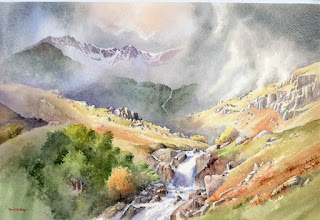For many years one of my ambitions has been to climb Mount Kenya to sketch those amazing peaks and the other-worldly plants that grow high on the mountain. Most people head for Kilimanjaro, as it’s the highest in Africa, but Mount Kenya is much more beautiful. So this month I thought if I don’t do it soon I never will.
I aimed to get up to around 14,000 feet from where I would be able to sketch the peaks. It’s not a difficult climb, but I’d been unwell with a chest infection most of the winter, and climbing to high altitude with breathing problems was a pretty crazy thing to do. Interestingly there are many wild animals on the slopes of the mountain: buffalo, elephant, panthers, and possibly the occasional lion, so hiking with that lot round the corner could be quite an experience!
I set off with a guide called Wilson, a cook and porter named Chris and a second porter, Stanley. Apart from my chest ailment I was also suffering from Delhi Belly, which tended to weaken me. Day 2 was an especial struggle. It began badly when, as I was eating breakfast in a hut a monkey ran in and grabbed my pancake, egg and a slice of bread, and shot off, leaving a trail of breakfast debris behind him. As the mountain lies on the equator the daytime heat was overpowering and although I only carried a daysack it was really heavy with extra water, sketching gear and all sorts of other gear. Heavy rain on the second day made things worse and high up I had to make frequent stops. By then we were amongst the exotic plants, so I sketched many of these as I rested. Eventually we found a cave to stay overnight, and as it had its own amazing garden of exotic plants I could happily sketch away from the cave entrance.
 Day 3 dawned bright and clear but I was eating my breakfast before dawn for an early start. After setting off we soon encountered ice-glazed rock. Six am on Mount Kenya is a magical time to be climbing, even when you are functioning well below par and this was the most enjoyable part of the climb. Wilson was extremely knowledgeable and we made better progress in the cool of the early morning. A glorious blue sky was punctuated only by strings of mare’s-tails over the peaks which rose sharply in front of us as we climbed a rocky ridge. I then sketched quickly, well aware that by late morning those peaks were likely to disappear, and sure enough, much earlier than I expected the clouds rolled in – lovely wispy airy clouds, but still gradually blotting out the view. This was disappointing, but I’d had a great few hours before the clouds arrived, and although my sketches were not my best, I had achieved what I came here to paint.
Day 3 dawned bright and clear but I was eating my breakfast before dawn for an early start. After setting off we soon encountered ice-glazed rock. Six am on Mount Kenya is a magical time to be climbing, even when you are functioning well below par and this was the most enjoyable part of the climb. Wilson was extremely knowledgeable and we made better progress in the cool of the early morning. A glorious blue sky was punctuated only by strings of mare’s-tails over the peaks which rose sharply in front of us as we climbed a rocky ridge. I then sketched quickly, well aware that by late morning those peaks were likely to disappear, and sure enough, much earlier than I expected the clouds rolled in – lovely wispy airy clouds, but still gradually blotting out the view. This was disappointing, but I’d had a great few hours before the clouds arrived, and although my sketches were not my best, I had achieved what I came here to paint.
I organised the trip through Mount Kenya Climbers, based in Naro Moru. Their contact address is info@mtkenyaclimbers.co.ke and my guide was Wilson Gatoto who is happy to arrange expeditions up many of East Africa’s mountains. His email address is legohi@yahoo.com Chris provided some excellent meals, but sadly I had little appetite. Stanley was a really cheerful and considerate fellow and as his daughter enjoyed art I gave him some paints, a brush and paper before I left. I did have further adventures with wildlife, but that’s another story…..
Like this:
Like Loading...





